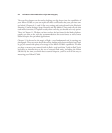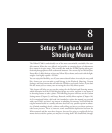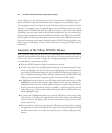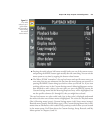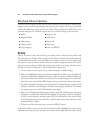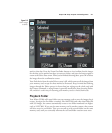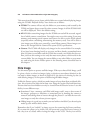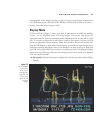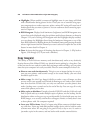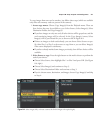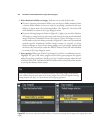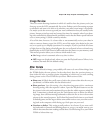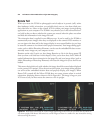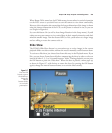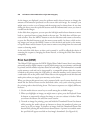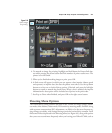■ Highlights. When enabled, overexposed highlight areas in your image will blink
with a black border during picture review. That’s your cue to consider using expo-
sure compensation to reduce exposure, unless a minus-EV setting will cause loss of
shadow detail that you want to preserve. You can read more about correcting expo-
sure in Chapter 4.
■ RGB histogram. Displays both luminance (brightness) and RGB histograms on a
screen that can be displayed using the up/down multi selector buttons, as shown in
Chapter 2. If you’re viewing this histogram with the Highlights display enabled,
you can change the Highlights focus from the luminance histogram to any of the
three RGB channels by holding down the Thumbnail button and pressing the multi
selector right button until the channel you want is selected. I explain the use of this
feature in more detail in Chapter 4.
■ Data. Activates the four pages of shooting data shown in Chapter 3. (Flip back to
Figures 3.20 through 3.23 if you need a refresher.)
Copy Image(s)
The ability to work with two memory cards simultaneously ranks as my absolutely
favorite feature of the Nikon D7000, way ahead of movie making by a long shot. One
of the best uses for two cards is to make back-up images while traveling, or at any other
time that your computer isn’t easily accessible. Here are some examples of what I do:
■ Shoot to two cards simultaneously. This gives you an instant backup in case pic-
tures on your primary card become corrupt or are erased. Ideally, your two cards
should be equal in size.
■ Make a copy. Use this Copy Image(s) facility to make a copy of images you shot
on one card to your second card. Instead of shooting on two cards at once (which
does slow down the D7000 a bit), use only one card when you take photos, then
make a backup onto a second card at the end of the day. You can copy all or only
some of the photos you’ve shot.
■ Make copies to distribute. I bought a bunch of 2GB SD cards for $4.98 each, and
find it’s quick and easy to make multiple copies of photos, not for backup, but for
distribution either on the spot, say, to provide models I’ve hired with some raw (not
RAW) images, or to send by snail mail to colleagues, friends, or family that I want
to share photos with. No computer required!
■ Leave your PSD at home. Since I’ve begun using Nikon cameras with dual mem-
ory card slots, I leave my hard disk/personal storage device with its built-in reader
at home more often. If I am going to be gone for only a day or two, it’s easier to
just make copies in the camera, and not bother with another external device.
David Busch’s Nikon D7000 Guide to Digital SLR Photography220



